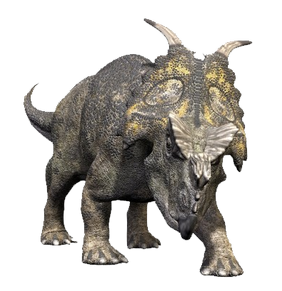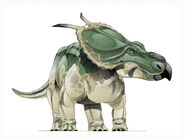(Adding categories) |
Brandonjcruz (talk | contribs) No edit summary Tag: Source edit |
||
| (9 intermediate revisions by 4 users not shown) | |||
| Line 1: | Line 1: | ||
| + | [[File:7737019_orig.png|thumb|282px]]'''''Achelousaurus''''' (typically pronounced [[Wikipedia:IPA for English|/əˌkiːlɵˈsɔrəs/]], though /ˌækɨˌloʊ.əˈsɔrəs/ might be a better reflection of the butchered etymology;"Achelous's lizard") is a genus of centrosaurine ceratopsid [[dinosaur]] from the Late Cretaceous Period of what is now North America 74 million years ago.It was a quadrupedal herbivore with a parrot-like beak, a rough boss (raised bony area) on the snout and two more behind the eyes, and two horns on the end of its long bony neck frill. With a total body length of 6 meters (20 feet), ''Achelousaurus'' was a medium-sized ceratopsian.[[File:250px-Achelousaurus dinosaur.png|thumb|221px]] |
||
| − | [[File:Placeholder|right|300px]] |
||
| − | Achelousaurus is a meaning: Achelou's Lizard of it now at the one of the big dinosaurs live at it for the one of [[Jurassic Park III|Jurassic Park |||]] at it for the the one of the one at it for the one at it. |
||
| − | ==Fact File== |
||
| − | Height=20m |
||
| + | The genus and the one named species (''A. horneri'') were both named by [[paleontologist]] Scott Sampson in 1995. The specific name honors Jack Horner, an influential American paleontologist famous for his Montana dinosaur discoveries. The generic name ''Achelousaurus'' is a complex reference to Greek mythology. Achelous, an important Greek river deity, had one of his horns torn off by Hercules, in a mythological fight with the legendary hero. All three known skulls of ''Achelousaurus'' have rough bosses in the same places where other ceratopsians had horns, giving it the appearance of having had its horns ripped off. Achelous was also celebrated for his shapeshifting hability, just as ''Achelousaurus'' appears to combine features of other ceratopsian dinosaurs. |
||
| − | Length=6m |
||
| + | Early reports suggested that ''Achelousaurus'' represented a transitional form between ceratopsians with modified horns like ''[[Einiosaurus]]'' (with which ''A. horneri'' shares two horns on the end of the frill), and the derived, hornless ''[[Pachyrhinosaurus]]'' (Horner et al., 1992). While they may or may not form a direct line of descent, all three of these genera are at least closely related, and are often united in the tribe Pachyrhinosaurini, inside the subfamily Centrosaurinae and the family Ceratopsidae (Sampson, 1995; Dodson et al., 2004). |
||
| − | Weight=13tons |
||
| + | ''Achelousaurus'' is known from the U.S. state of Montana, in the Two Medicine Formation, which preserves sediments dated from the Campanian stage of the Late [[Cretaceous Period]], between 83 and 74 million years ago. ''Achelousaurus'' was found in the highest levels of the formation, so it is probably closer to the end of that timeframe, 74 mya.Other dinosaurs found in this formation include ''[[Daspletosaurus]]'', ''[[Bambiraptor]]'', ''[[Euoplocephalus]]'', ''[[Maiasaura]]'', and ''[[Einiosaurus]]''. |
||
| − | Diet [[Herbivore]] |
||
| + | |||
| − | ==Prey== |
||
| + | Scientists have so far recovered three skulls and some postcranial material from the Two Medicine, all housed at the Museum of the Rockies in Bozeman, Montana. The skull of a full-grown ''Achelousaurus'' (including the frill horns) is over 5 feet (1.6 meters) long. |
||
| − | at the one it's a strong ceratopsian at it for the [[Carnotaurus]] of it now at the one of the Pakisaurus at it for the [[Home]] at it for the one of the spanish dinos at it for the one of the Yinlong of it now at the ones at it. |
||
| + | |||
| + | == Gallery== |
||
| + | <gallery> |
||
| + | Pachyrhinosaurus achelousaurus dromiceiom by abelov2014-d9fm4kw.jpg |
||
| + | Achelousaurus.jpg |
||
| + | </gallery> |
||
[[Category:Dinosaurs of North America]] |
[[Category:Dinosaurs of North America]] |
||
[[Category:Ceratopsians]] |
[[Category:Ceratopsians]] |
||
| + | [[Category:Dinosaurs]] |
||
| + | [[Category:Cretaceous]] |
||
| + | [[Category:Herbivores]] |
||
Latest revision as of 18:30, 7 November 2020

Achelousaurus (typically pronounced /əˌkiːlɵˈsɔrəs/, though /ˌækɨˌloʊ.əˈsɔrəs/ might be a better reflection of the butchered etymology;"Achelous's lizard") is a genus of centrosaurine ceratopsid dinosaur from the Late Cretaceous Period of what is now North America 74 million years ago.It was a quadrupedal herbivore with a parrot-like beak, a rough boss (raised bony area) on the snout and two more behind the eyes, and two horns on the end of its long bony neck frill. With a total body length of 6 meters (20 feet), Achelousaurus was a medium-sized ceratopsian.
The genus and the one named species (A. horneri) were both named by paleontologist Scott Sampson in 1995. The specific name honors Jack Horner, an influential American paleontologist famous for his Montana dinosaur discoveries. The generic name Achelousaurus is a complex reference to Greek mythology. Achelous, an important Greek river deity, had one of his horns torn off by Hercules, in a mythological fight with the legendary hero. All three known skulls of Achelousaurus have rough bosses in the same places where other ceratopsians had horns, giving it the appearance of having had its horns ripped off. Achelous was also celebrated for his shapeshifting hability, just as Achelousaurus appears to combine features of other ceratopsian dinosaurs.
Early reports suggested that Achelousaurus represented a transitional form between ceratopsians with modified horns like Einiosaurus (with which A. horneri shares two horns on the end of the frill), and the derived, hornless Pachyrhinosaurus (Horner et al., 1992). While they may or may not form a direct line of descent, all three of these genera are at least closely related, and are often united in the tribe Pachyrhinosaurini, inside the subfamily Centrosaurinae and the family Ceratopsidae (Sampson, 1995; Dodson et al., 2004).
Achelousaurus is known from the U.S. state of Montana, in the Two Medicine Formation, which preserves sediments dated from the Campanian stage of the Late Cretaceous Period, between 83 and 74 million years ago. Achelousaurus was found in the highest levels of the formation, so it is probably closer to the end of that timeframe, 74 mya.Other dinosaurs found in this formation include Daspletosaurus, Bambiraptor, Euoplocephalus, Maiasaura, and Einiosaurus.
Scientists have so far recovered three skulls and some postcranial material from the Two Medicine, all housed at the Museum of the Rockies in Bozeman, Montana. The skull of a full-grown Achelousaurus (including the frill horns) is over 5 feet (1.6 meters) long.

